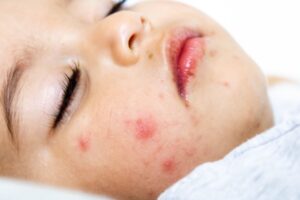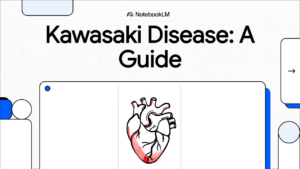Introduction: What This Guide Covers
This guide is designed for parents and caregivers to provide clear, essential information about Kawasaki Disease in simple, easy-to-understand terms. We know that hearing a new medical diagnosis for your child can be overwhelming, and our goal is to offer a reliable starting point for your questions.
This document will explain what Kawasaki Disease is, the risk factors associated with it, the key signs you should watch for in your child, and what comfort measures you can take at home while awaiting a professional medical diagnosis.
It is important to remember that while Kawasaki Disease is a serious condition requiring medical attention, effective treatments are available. This guide provides the foundational knowledge to help you understand the illness and navigate your concerns with confidence.


Podcast:
Learn More About Kawasaki's
1. What is Kawasaki Disease?
Understanding the basic nature of this illness is the first step for parents to recognize its potential seriousness and the importance of seeking timely medical advice.
In simple terms, Kawasaki Disease is a condition that involves the inflammation of small- and medium-sized blood vessels throughout a child’s body.
The primary area of concern is the disease’s particular impact on the coronary arteries, which are the blood vessels around the heart.
While this can sound alarming, it’s helpful to know that the disease primarily affects specific groups of children, which we will explore next.
2. Who is Most at Risk?
Knowing the common risk factors can help parents and caregivers understand if their child falls into a higher-risk category, promoting earlier awareness and observation. The main risk factors include:
- Age: The disease most often affects children under 5 years old. The highest number of cases occurs in toddlers between 1 and 2 years of age. It is uncommon in children over the age of 14.
- Gender: It is diagnosed more frequently in boys than in girls.
- Ethnic Background: While children of all ethnic origins can get Kawasaki Disease, the highest rates are seen in children of Asian descent, particularly those of Japanese heritage.
Understanding these risk factors helps with awareness, but the natural next question for parents is what actually causes the illness.
3. What Causes Kawasaki Disease?
One of the first questions any parent has when their child is sick is about the cause and whether it could have been prevented.
The exact cause of Kawasaki Disease is currently unknown to medical experts.
However, it is crucial for families to know that Kawasaki Disease is not contagious and cannot be passed on to other family members.
Since the cause is unknown, the most effective tool a parent has is the ability to recognize the key signs and symptoms of the disease.
4. Key Signs and Symptoms to Watch For
Because there is no single test to diagnose Kawasaki Disease, doctors rely on a specific combination of signs and symptoms. Recognizing this pattern is critical for getting a timely diagnosis and starting treatment.
The primary symptom and a requirement for diagnosis is a persistent high fever.
- High Fever: A key sign of Kawasaki Disease is a high fever (exceeding 39°C) that lasts for at least 5 days.
In addition to the fever, a diagnosis typically requires at least four of the following five physical signs:
- Rash A varied rash may appear on the body. It can sometimes look like measles, with red patches and bumps, or have a target-like appearance.
- Mouth and Lip Changes Look for significant redness inside the mouth and throat, a bright red tongue that may look like a strawberry (often called a “strawberry tongue”), and dry, red, or cracked lips.
- Eye Redness The whites of the eyes may become red. A key feature is that this redness occurs without any sticky discharge or pus.
- Hand and Foot Changes You may notice swelling in your child’s hands and feet. The palms of the hands and soles of the feet can also become red. Later in the illness, often after other symptoms have started to resolve, the skin around the fingernails and toenails may begin to peel.
- Swollen Lymph Gland Typically, a single lymph gland in the neck becomes swollen, usually on one side. To be considered a key sign for diagnosis, the gland must be at least 1.5 cm in size.
Some children may also experience other symptoms, including being unusually irritable, abdominal pain, diarrhea, joint pain, or pain during urination.
Recognizing these signs is the most critical step; now, let’s discuss what you can do to keep your child comfortable while you seek a medical opinion.
5. Managing Your Child’s Comfort at Home
While you are observing your child and awaiting a doctor’s formal diagnosis, you can take steps at home to manage their discomfort from the fever and associated pain.
Fever and pain-reducing medications can be used to help manage your child’s symptoms until the fifth day of the fever, which is the point at which a diagnosis can often be made.
It is crucial to understand that these medications are for comfort only and are not a treatment for the disease itself. If you suspect your child has Kawasaki Disease based on the signs described above, seeing a doctor is essential.
The most important action a parent can take is to seek a professional medical evaluation to get an accurate diagnosis and begin the appropriate treatment plan for your child.
